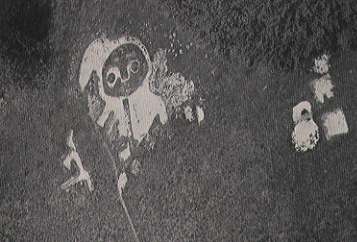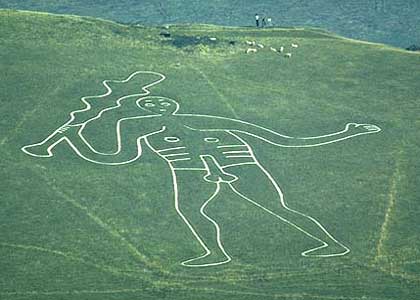|


text translation service for 25 worldwide languages
The
figure shown below is in Wandlebury, England. Note the similarity to the
figures on the Nazca plain, Peru, in the way the eyes are very large.
In fact large eyes seem to be a common feature of many ancient geoglyphs.
Unfortunately, because of the current climate in north-western Europe
figures like this that were drawn in the landscape millennia ago are being
lost because they don’t enjoy the dry heat of the Nazca day, nor the intense
cold at night.

The figures
in Peru are believed to date from around 600 BC, but the Cerne Abbas Giant
below is believed to be very much older. It has been formed by deep trenches
cut into the turf covering chalk hill close to the village of Cerne Abbas,
and above its head you can see the ‘Maypole
Mound’, which was still in use in the 17th century.
The outline
of the giant has been maintained by each successive generation of local
inhabitants for at least 3,000 years, and some feel that it is even older
still. The website we found it on focusses on geoglyphs ancient and modern,
and you can access it by clicking on the image. It has an interesting
quote about pagan May Day festivities from the book ‘Anatomy
of Abuses’ (1583),
in which the author Philip Stubbs wrote:
“Hundreds
of men, women, and children go off to the woods and groves and spend all
the night in pastimes, and in the morning return with birch boughs and
branches of trees to deck their assembles withall….I have heard it credibly
reported by men of great gravity that, of a hundred maids going to the
woods, there have scarcely the third part of them returned home again
as they went.”
According
to the ‘Hill
Figures’ website designer, Maypole dancing still occurred at the
site as recently as 1635 when Christian authorities finally suppressed
the pagan festivals:
“During prudish Victorian times the trenches of the giant’s penis were
filled with dirt and hidden beneath grass. The giant, whose name may derive
from the Celtic fertility god Cernunnos, has the legendary power to cure
barrenness in women, and childless couples still copulate while lying
on the grass in the giant’s phallus. A sight line taken up the giant’s
penis on May Day points directly at the sun as it rises over the crest
of the hill.”

These
figures were cut into the topsoil revealing the chalk below. Could it
possibly be that the various cultural upheavals that are evident throughout
the past few thousand years will show the destruction of civilsations
of antiquity that were in previous times in close contact with each other?
Can the evidence of the similarities in the geoglyphs of various cultures
contribute to solving these mysteries, or have many thousands more geoglyphs
arounf the world been deliberately destroyed by prudish bigots using spurious
‘religious’authority’ to justify
their destruction of things they didn’t understand?
Probably
the best known geoglyphs are those which make up the so-called “Glastonbury’s
Temple of the Stars”, which was first published in 1927, and which
has just been reprinted. In this seminal work on the phenomena that has
become known as ‘terrestrial zodiacs’,
Katherine Maltwood drew attention to the existence of geoglyphs in Pyrdein.
These are made up of the roads, ancient pathways, and often rivers and
stream courses, according Maltwood – something which has served to undermine
the idea due to their constant changes of course in relatively short periods
of time.
But
ancient people appear to have used landscape drawings to represent temples
which mirror celestial order as they saw it in various countries around
the world. The Glastonbury ‘zodiac
temple’ is still a source of major controversy, as archæologists
continue to deny the ‘possibiliy’
that ancient peoples could have had, or even developed for that matter,
the sophistication of thought and society to built them. Increasingly
they are being proved wrong as the remains of many more ancient geoglyphs
are discovered by satellite-based technologies.
return to geoglyphs
read Owen Morien Morgan’s classics
“The Mabin of the Mabinogion”
“Light of Britannia”
the key to the ancient druidic astro-mythology
please take a look at our Ancient Mysteries Bookshoppe for a wide selection of books
that challenge orthodox views of prehistory on every continent
|